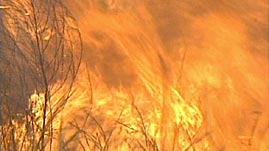Teachers' Domain - Digital Media for the Classroom and Professional Development
User: Preview

Source: NASA/Goddard Space Flight Center
Droughts claim more victims each year than any other natural disaster. Depending on where it occurs and how long it persists, the cost of a drought can run into the billions of dollars. Droughts cause more than economic hardship, however. As this video segment adapted from NASA's Goddard Space Flight Center demonstrates, droughts have a complex web of impacts that also affect us socially and environmentally.
In broad terms, any temporary shortage of water for the normal needs of agriculture, livestock, industry, or human population may be termed a drought. The cause may be a lack of supply, contamination, inadequate storage, or unusually high demand. Although some people may associate droughts only with dry climates, water shortages are a normal and recurrent feature of virtually all climatic zones, even those that typically enjoy adequate rainfall and soil moisture levels. The severity of the drought depends upon the degree of moisture deficiency, the duration, and the size of the affected area.
Droughts due to a lack of supply are usually the result of shifts in global wind patterns that allow widespread high-pressure systems to persist over land for weeks, months, or even years. In high-pressure systems, air sinks, or subsides. Subsiding air prevents moisture in the air from rising, so clouds cannot form. The dry conditions continue until the high-pressure system gets shifted out of the way. Present-day atmospheric circulation tends to create subsidence in the subtropical latitudes of both hemispheres, so these regions — which include sub-Saharan Africa, parts of Brazil and India, and the Philippines — are especially prone to drought.
Although the causes for drought are usually natural, human beings can increase the impact. Overgrazing, improper soil management, and poor crop selection can stress local water supplies. Clearing land for development or mining changes the surface conditions, which can alter local weather conditions and invite drought.
An extended drought can have debilitating effects on both rural and urban populations. As the moisture content of the soil diminishes, agriculture is quickly affected. The primary effects of a drought are loss of crops, livestock, and water used for consumption. If resulting food shortages become chronic, famine can occur. Secondary effects of drought may include fires, flash flooding, and desertification, the last of which results from increased wind erosion of soils. Wind-blown ash and dust can also compromise the air quality of far-distant areas. In these ways, even localized droughts can have global consequences.
A balanced agricultural program that develops and maintains good water resources, addresses the problems of soil erosion, and carefully manages livestock grazing can help mitigate the effects of drought.
 Loading Standards
Loading Standards Teachers' Domain is proud to be a Pathways portal to the National Science Digital Library.
Teachers' Domain is proud to be a Pathways portal to the National Science Digital Library.
